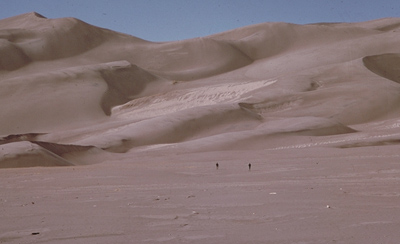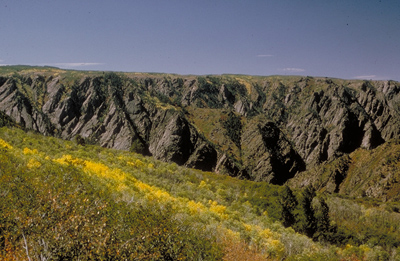
Flight 93 Memorial becomes park site
The Flight 93 National Memorial in Somerset County, Pa., is the first national park in the nearly 100-year-old history of the National Park Service created through an open design competition.
The memorial, to be dedicated in 2011 on the 10th anniversary of the Sept. 11 attacks, is one of the newest additions to National Park Service collection of almost 400 units.
The latest addition to the national parks system, the 391st, was formalized in spring 2007. Sand Creek National Historic Site in southeastern Colorado was officially added at the end of April. The site memorializes the massacre of about 160 Cheyenne and Arapaho tribe members in their villages along Sand Creek by U.S. Army soldiers in 1864.
When it comes to forming new national parks such as the Flight 93 Memorial or the Sand Creek site, a proposed unit is subject to an extensive process of study and review as determined by the Historic Sites Act of 1935. Some of the aspects examined are the site’s history, integrity and feasibility.
Although all national parks are established by Congress through a national act, each one typically comes about in its own unique way.

The Flight 93 National Memorial proposed by architects that won the national design competition for the
memorial desaign. This view was released to the public by Paul Murdoch Architects in spring 2006 (Illustration by Aleksander Novak-Zemplinski, courtesy of Flight 93 National Memorial, Paul Murdoch Architects, Los Angeles, and the National Park Service).
“There is no clear-cut answer,” said Harry Butowsky, a National Park Service historian and manager of the National Park Service history website. “More often than not, a local group gets in contact with a senator and then they drop a bill in.”
For example, to protect Philadelphia’s historic landmarks, the Independence Hall Association relentlessly worked for the formation of Independence National Park during the 1940s. Their efforts succeeded in 1948 when U.S. Rep. Hardie Scott introduced a bill authorizing the creation of the park.
On the other hand, in 1864, President Abraham Lincoln signed a bill granting the Yosemite Valley to California as protected public land. Eventually this conservation would lead to the establishment of Yosemite National Park in 1890.
“The president can make an executive order under the antiquities act of 1906 as long as the land is under federal ownership,” Butowsky said. “An example of this is in 1979, when President Carter established 22 national monuments in Alaska.”
National parks are popular, and so many places want one that there are usually 40 or 50 sites in consideration at any one time.
“Everybody wants a park and money is very important,” Butowsky said. “Often an area wants a park to increase tourism, but they want the government to finance it.”
The Flight 93 National Memorial is being funded by a public-private relationship and the cost is currently estimated to be around $60 million. The federal government and the state of Pennsylvania have each supplied $10 million and the rest is to be raised in the private sector spearheaded by the Flight 93 Capital Campaign.
| Great Sand Dunes National Park and Preserve in Colorado became a national monument in 1932, but became a park just recently, in 2000 (Photo courtesy of the National Park Service). |  |
Sources of funding, usually federal and state governments, is a make or break aspect when considering new national parks.
“Politics trump everything,” Butowsky said. “Economic factors are key.”
Another important phase in creating national parks is planning. This planning involves design and construction schematics, roads, parking, facilities, boundaries and visitor centers.
“The park service, in conjunction with its partners, has carefully considered every aspect of what the infrastructure must be,” said Bill Haworth, a public relations spokesperson for the Flight 93 Memorial. “In the last several months, the architect has been working to finalize these plans.”
The park planning for the Flight 93 Memorial deviates from the norm in that its design was chosen from more than 1,000 entries in an open competition.
“It was felt by the family members that the design competition, like what was done for the Vietnam Memorial, would be the most inclusive way to design a memorial,” Haworth said.
Paul Murdoch Architects designed the winning entry, picked by a jury of prominent individuals in architecture design, landscape design, as well as members of the victims’ families.
The design itself includes a large bowl made up of 40 groves of red maple trees to honor each victim, a large tower with 40 wind chimes, a black slate outlining the flight path and an area to view the sacred ground where the passengers lost their lives.
Almost immediately after being chosen, the design came under criticism because many felt that the bowl’s crescent design strongly resembled a symbol associated with Islam. Such a symbol is found on the flags of Turkey and Pakistan.
“All of the partners do not in anyway agree with the connection between this (and the Islamic crescent),” Haworth said.
Nonetheless, changes have been made to create a more circular layout.
“The family members are completely happy with the design,” Haworth said.
 |
Black Canyon of the Gunnison National Park in Colorado became a park in 1999 (Photo courtesy of the National Park Service). |
Once the Flight 93 National Memorial is completed, the National Park Service expects about one half million visitors a year. Currently, people visiting the site can view a temporary memorial as well as the actual crash site. A local group of volunteers called the Flight 93 Memorial Ambassadors are there to offer information and maintain the area.
Can Americans expect more new national parks in the future? There is not a shortage of proposed locations, but there is a shortage of funding.
“Congress likes to pass parks, but they don’t like to get the budget,” Butowsky said.
Some areas currently under Congressional consideration for federal protection are the lands adjacent to Walnut Canyon in Arizona, portions of the red rock canyons in Utah, the prehistoric fossilized trackways in New Mexico and a national memorial in Texas commemorating the Space Shuttle Columbia.

Comments are Closed